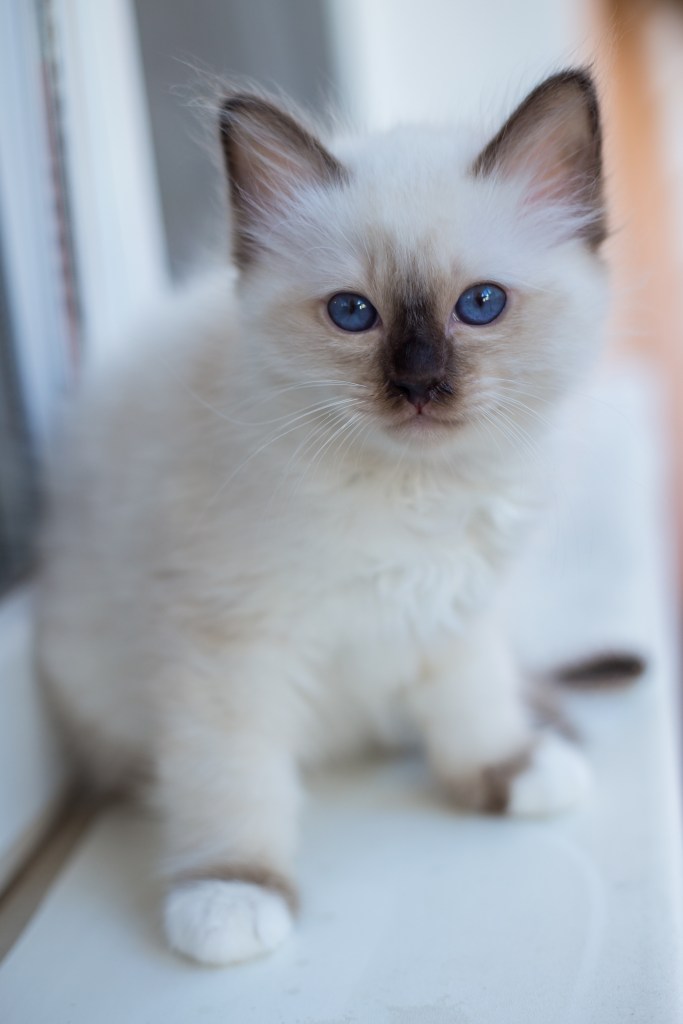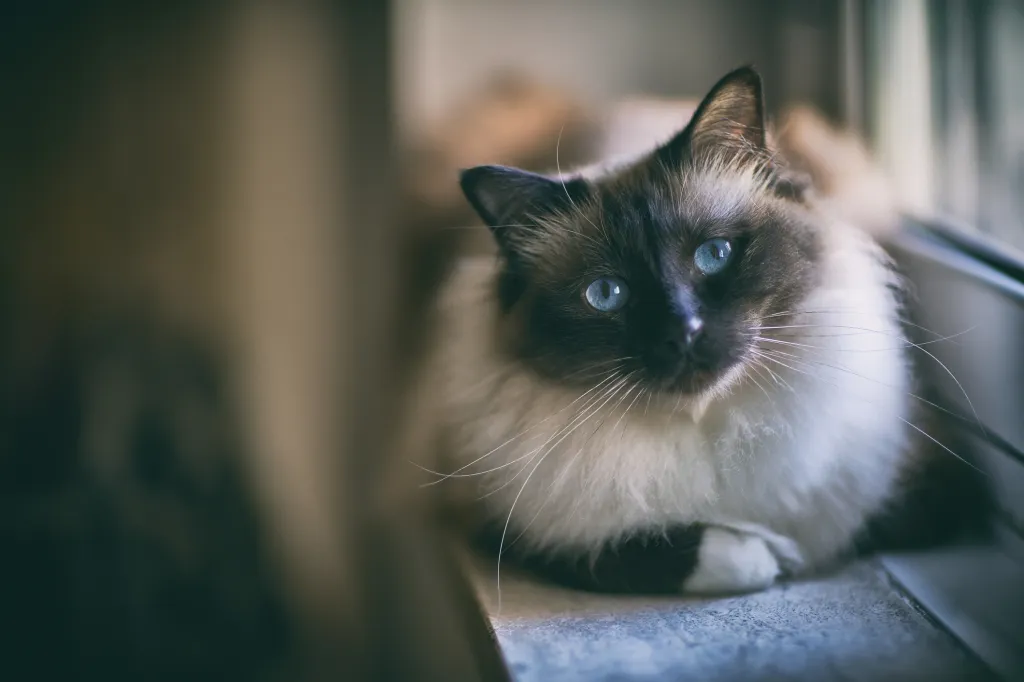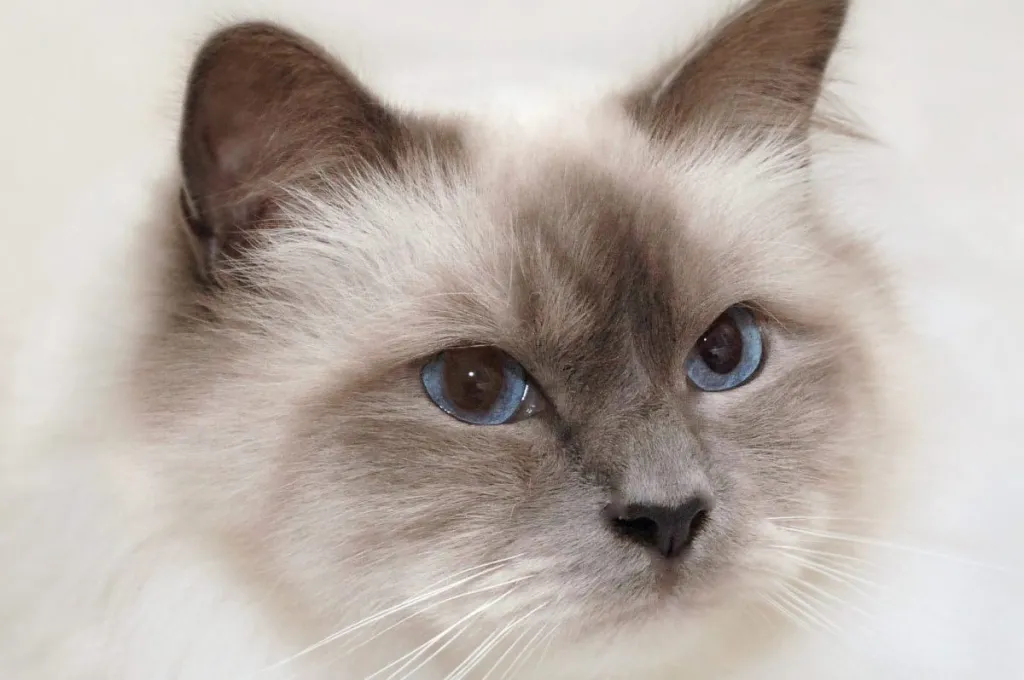Birman cats, known for their enchanting beauty and bright blue eyes, are a distinctive breed that exudes elegance and charm. Originating from Burma (now Myanmar), these feline companions are medium to large size with silky semi-longhair coats. Their color-point pattern is reminiscent of Siamese cats and luxurious fur comes in a variety of colors, with the signature darker points contrasting against a lighter body. Beyond their striking appearance, Birmans are revered for their friendly and affectionate nature, making them sought-after companions for cat lovers around the world.
When considering a Birman cat, it’s advisable to prioritize adopting from rescue organizations or shelters to provide a loving home to a cat in need. However, if you decide to purchase a Birman kitten, it’s crucial to choose a reputable breeder. Conduct thorough research to ensure that the breeder follows ethical practices and prioritizes the well-being of their cats. Reputable Birman cat breeders prioritize the health and temperament of their cats, conduct necessary health screenings, and provide a nurturing environment for the kitties. This active approach ensures that you bring home a healthy and happy kitty while discouraging unethical breeding practices.
Quick Facts
- Origin: Burma (now Myanmar), believed to be an ancient temple breed with a mystical history.
- Size: Medium (8-12 pounds), with males generally larger than females.
- Breed Group: Longhair (Persian)
- Lifespan: 9-13 years
- Coat: Long, silky, and luxurious, with white “gloves” on paws and distinctive color “points” on face, ears, legs, and tail. Colors include seal, chocolate, blue, lilac, red, cream, cinnamon, fawn, and more.
- Temperament: Gentle, affectionate, calm, playful when young, enjoys lounging and attention.
- Exercise Needs: Moderate – appreciates playtime but content with quiet cuddles.
- Training: Can be trained with patience and positive reinforcement, more independent than some cat breeds.
- Grooming: Daily brushing is essential to prevent matting, especially with their long, thick fur.
- Health: Generally healthy, but prone to some genetic conditions like brachycephalic syndrome (due to flat face) and polycystic kidney disease.
- Like all color-point breeds, Birman cats are born white and develop their coat over time. The Birman takes about two years to develop its coat.
- Choupette is a white Birman who was owned by the late Karl Lagerfeld. The cat was named in his will and earned millions of dollars staring in fashion campaigns.
- The main legend surrounding the origins of the Birman cat say it received blue eyes from a goddess and its paws remain white due to purity.
Birman Pictures




-
Affectionate with Family
Some cat breeds are typically independent and aloof, even if they’ve been raised by the same person since kittenhood; others bond closely to one person and are indifferent to everyone else; and some shower the whole family with affection. Breed isn’t the only factor that goes into affection levels; cats who were raised inside a home with people around feel more comfortable with humans and bond more easily.

See Cats Less Affectionate with Family -
Amount of Shedding
If you’re going to share your home with a cat, you’ll need to deal with some level of cat hair on your clothes and in your house. However, shedding does vary among the breeds. If you’re a neatnik, you’ll need to either pick a low-shedding breed or relax your standards. This furniture cover can make it easier to clean up cat hair and keep it off your sofa!
-
General Health
Due to poor breeding practices, some breeds are prone to certain genetic health problems. This doesn’t mean that every cat of that breed will develop those diseases; it just means that they’re at an increased risk. If you’re looking only for purebred cats or kittens, it’s a good idea to find out which genetic illnesses are common to the breed you’re interested in.
-
Potential for Playfulness
Some cats are perpetual kittens—full of energy and mischief—while others are more serious and sedate. Although a playful kitten sounds endearing, consider how many games of chase the mouse-toy you want to play each day, and whether you have kids or other animals who can stand in as playmates. A classic wand cat toy like this one is perfect for playful felines!
-
Tendency to Vocalize
Some breeds sound off more often than others with meows, yowls, and chattering. When choosing a breed, think about how the cat vocalizes and how often. If constant “conversation” drives you crazy, consider a kitty less likely to chat.
-
Kid-Friendly
Being tolerant of children, sturdy enough to handle the heavy-handed pets and hugs they can dish out, and having a nonchalant attitude toward running, screaming youngsters are all traits that make a kid-friendly cat. Our ratings are generalizations, and they’re not a guarantee of how any breed or individual cat will behave; cats from any breed can be good with children based on their past experiences and personality.
-
Friendly Toward Strangers
Stranger-friendly cats will greet guests with a curious glance or a playful approach; others are shy or indifferent, perhaps even hiding under furniture or skedaddling to another room. However, no matter what the breed, a cat who was exposed to lots of different types, ages, sizes, and shapes of people as a kitten will respond better to strangers as an adult.
-
Easy to Groom
Some breeds require very little in the way of grooming; others require regular brushing to stay clean and healthy. Consider whether you have the time and patience for a cat who needs daily brushing. You should definitely pick up this awesome de-shedding tool for cats of any hair length!
-
Intelligence
Some cat breeds are reputed to be smarter than others. But all cats, if deprived the mental stimulation they need, will make their own busy work. Interactive cat toys are a good way to give a cat a brain workout and keep them out of mischief. This scratcher cat toy can keep your smart kitty busy even when you’re not home!
-
Pet Friendly
Friendliness toward other household animals and friendliness toward humans are two completely different things. Some cats are more likely than others to be accepting of other pets in the home.
Birman History
A beautiful cat deserves a beautiful legend of origin. The Sacred Cat of Burma, as the Birman is sometimes called, is said to have acquired his striking appearance through the intervention of a blue-eyed goddess, who rewarded a temple cat’s love for and devotion to his priest by turning his white coat golden and changing his yellow eyes to blue. His paws remained white as a symbol of his purity. Ever since, the temple cats have borne the goddess’s marks of favor, and it was said that priests who died were reborn into the cats’ bodies.
How the cats really came to be is unknown. Theories include crosses of Siamese with Angoras or Persians, but when or where those original meetups occurred is unknown. They may have taken place in southeast Asia, between various cats who carried the genes for a pointed pattern, long hair and blue eyes, or the breed may have been created in France from cats imported by two Europeans, a Frenchman named Auguste Pavie, and a Major Gordon Russell, who were given a pair of temple cats in 1919 as a reward for aiding the priests.
The cats were shipped to France, but the male did not make it there alive. Before he died, however, he had impregnated the female, and her kittens helped to establish the breed in Europe. It was recognized in France in 1925 as the Sacre de Birmanie, from which comes the current breed name, Birman.
The cats were first imported to the United States in 1959 and were recognized by the Cat Fanciers Association in 1967. They are also recognized by the American Cat Fanciers Association, the Canadian Cat Association, the Cat Fanciers Federation and The International Cat Association.
Birman Size
Birmans typically weigh 6 to 12 pounds.
Birman Personality
If you like the pointed pattern of the Siamese but not the yowly voice, a Birman might be the cat for you. He is a docile, quiet cat who loves people and will follow them from room to room. Expect the Birman to want to be involved in what you’re doing, and be grateful that he’s not as bossy as the Siamese.
Docile doesn’t mean dumb. The Birman is a smart cat and, of course, curious. He likes to explore his environment and has been known to get trapped underneath floors that are being replaced or to accidentally (maybe on purpose) go for a ride on top of a car. It’s a good idea to always keep tabs on where he is.
He communicates in a soft voice, mainly to remind you that perhaps it’s time for dinner or maybe for a nice cuddle on the sofa. He enjoys being held and will relax in your arms like a furry baby.
Birman Health
Both pedigreed cats and mixed-breed cats have varying incidences of health problems that may be genetic in nature. Problems that may affect the Birman include the following:
- Congenital Hypotrichosis: This causes them to be born with no hair.
- Thymic Aplasia: This is an immune deficiency that leads to increased risk of infection and death. Fortunately, these conditions are rare.
- Corneal Dermoid: Corneal dermoid is a relatively rare but specific congenital eye condition that can affect Burmese cats, as well as cats of other breeds. Corneal dermoids are benign growths or tumors on the cornea, which is the clear, outermost layer of the eye. These growths consist of tissue elements, such as hair, skin, or sweat glands, that should not be present on the cornea. It can be corrected surgically.
- Spongiform Degeneration: A progressive degenerative disease of the central nervous system causing signs that include hind-limb weakness and uncoordinated movement.
- Shaking and Trembling in Kittens: This condition begins in some kittens when they are about 10 days old and lasts until they are about 12 weeks old. The cause is unknown and recovery occurs spontaneously.
- Kidney Disease: Unusually high concentrations of urea and/or creatinine in the blood, which may or may not indicate kidney dysfunction.
Birman Care
Despite the length of the Birman’s coat, it has a silky texture that doesn’t mat easily. Comb it weekly to remove dead hair and distribute skin oils. Birmans shed their winter coat in the spring, so you may want to comb more frequently then to remove loose hair. A warm bath can also help to loosen and remove the shedding coat. To accomplish a Birman bath, wetting the cat with a hand-held shower nozzle is often preferable to immersing him in a tub of water.
Brush the teeth to prevent periodontal disease. Daily dental hygiene is best, but weekly brushing is better than nothing. Trim the nails every couple of weeks. Wipe the corners of the eyes with a soft, damp cloth to remove any discharge. Use a separate area of the cloth for each eye so you don’t run the risk of spreading any infection.
Check the ears weekly. If they look dirty, wipe them out with a cotton ball or soft damp cloth moistened with a 50-50 mixture of cider vinegar and warm water. Avoid using cotton swabs, which can damage the interior of the ear. Keep the Birman’s litter box spotlessly clean. Cats are very particular about bathroom hygiene, and a clean litter box will help to keep the coat clean as well.
It’s a good idea to keep a Birman as an indoor-only cat to protect him from diseases spread by other cats, attacks by dogs or coyotes, and the other dangers that face cats who go outdoors, such as being hit by a car. Birmans who go outdoors also run the risk of being stolen by someone who would like to have such a beautiful cat without paying for it.
Birman Coat Color And Grooming
The Birman has a silky, medium-length coat in the pointed pattern of the Siamese (meaning that the color is darker on the face, ears, legs and tail), a broad, rounded head topped with medium-size ears, bright blue eyes that give him a sweet expression, and four white feet that give him the appearance of wearing little white mittens.
This is a medium-size to large cat with a stocky, powerful body that belies his gentle demeanor. The medium-long to long coat has a silky texture and little undercoat, which means that it rarely mats. It forms a heavy ruff around the neck and is wavy on the belly.
A pale body, which varies in shade depending on the cat’s color, is set off by darker points. For instance, a seal point Birman has a body that is a pale fawn to cream color with a warm tone, gradually shading to a lighter color on the belly and chest. The points are a deep seal brown. On the front and back paws are white “gloves” ending in an even line across the paw. On the back paws, the gloves extend up the back of the leg (called laces) and end in a point or an inverted V shape. In the show ring, the symmetry of the “gloves and laces” are an important factor and may mean the difference between a kitten going on to a career as a show cat or as a pet.
Besides seal point, Birmans come in blue point, chocolate point, lilac point, and various parti-color point and lynx point colors. Lynx point Birmans have a clearly defined M marking on the forehead, light markings that resemble eyeglasses around the eyes, spotted whisker pads, solid-colored ears with no stripes, and “thumb marks” on the back of the ears. The legs and tail have stripes and rings.
Children And Other Pets
The friendly, laidback Birman is a perfect choice for families with children and cat-friendly dogs. He loves the attention he receives from children who treat him politely and with respect, and he doesn’t mind playing dress-up or going for a ride in a baby buggy.
He is happy to live with cat-friendly dogs, too, thanks to his amiable disposition. Introduce pets slowly and in controlled circumstances to ensure that they learn to get along together.
Birman Rescue Groups
More Info For You
If you’re also looking for a dog, check out DogTime’s dog breed page!





